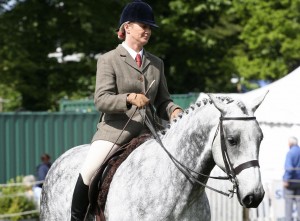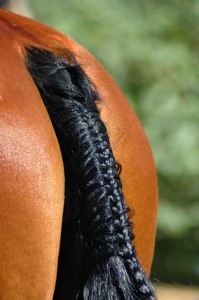At last! Spring has sprung, and many equestrians have embarked on the newly commenced showing season. Regardless of the type of horse, whether a show hunter, hack, cob, native type or miniature, for any horse owner involved in showing, appearance is everything. After all, the art of successful showing lies in presenting an attractive picture to the judge.
The build up to a show and the preparation on the day can sometimes be very stressful. It’s best to prepare well in advance, so head down to your local tack shop for anything you think you might need to give your horse that professional finish.
Equine shampoo is a must-have item, and there are many different brands on the market, some of which are based on purely
natural ingredients for horse owners wanting to take a more natural approach. Don’t forget stain removers for greys, and the good old equivalent of the blue rinse to get the yellowness out of grubby tails. Coat conditioner and mane and tail de-tangler are also essential purchases, as is some form of hoof preparation, be it black or clear, paint or oil, liquid or solid. Varnish-based hoof dressings can be harder to remove, whereas water-based hoof paint will still stay shiny for a couple of days and is far easier to remove.
Show preparation wouldn’t be complete without careful trimming and tidying, so look for tools to make your job as easy and effective as possible. A grooming belt can be another useful piece of equipment. Some of the smaller items can sometimes be overlooked, like plaiting thread, bands, needles, cotton and un-pickers, so ensure you remember to stock up! Scissors are always handy for plaiting activities and trimming. Mane and tail control sprays add that extra grip during plaiting and most keep plaits held firmly in place and are easy to brush out after use.
make your job as easy and effective as possible. A grooming belt can be another useful piece of equipment. Some of the smaller items can sometimes be overlooked, like plaiting thread, bands, needles, cotton and un-pickers, so ensure you remember to stock up! Scissors are always handy for plaiting activities and trimming. Mane and tail control sprays add that extra grip during plaiting and most keep plaits held firmly in place and are easy to brush out after use.
When it comes to showing tack meanwhile, whether it’s an in-hand bridle or working hunter saddle, quality makes a strong impression. Select high-quality tack that is well fitted and comfortable for both yourself and your horse, and invest in some cleaning and conditioning products to keep it in a show ring condition.
Of course, once you’ve adorned your horses for the show ring with gleaming coats, plaited manes and tails and immaculate tack, the next step is to simply keep them this way. Rugs, bandages, hoods and waterproof showing macs will keep
them clean until they step into competition territory.
When stood in the show ring being examined by the judge, the show horse or pony needs to be in the best condition possible. There’s only so much magic cleaning and cosmetic products can do and the remaining form is down to a balanced and nutritional diet.
However, a well-conditioned horse, especially in the showing world, is often mistaken for an overweight one, which over the past few years has turned into a major concern.
What has misled owners and breeders to believe horses are healthy and beautiful when carrying excessive weight is unknown; perhaps they are mistaking fat for muscle.
Many welfare organisations have reported seeing more cases of overweight horses than emaciated ones. The extra fat can result in breathing difficulties and unnecessary strain on the joints and spine, with ponies especially, living on the brink on laminitis. Make sure you are not over-feeding your horses; judges do not like fat horses in the ring, and it’s certainly not good for them.
Generally it is accepted that a horse or pony in ‘good condition’ has a nice rounded outline, bright eyes, an alert expression, strong smooth hooves, soft relaxed muscles, a glossy coat and skin that moves slightly under light hand pressure.
Whatever the showing class, adopting the correct dress code is of paramount importance, as is fit. No matter how much you pay for a jacket, if the sleeves are too short or the back is so long that you end up sitting on the tail, the resulting picture will fail to impress. But, if the jacket fits well and is made with quality materials and care, it will always look good. A look that is  sophisticated and tasteful in styles and colours will set off and add to a horse’s elegance and beauty in the show ring.
sophisticated and tasteful in styles and colours will set off and add to a horse’s elegance and beauty in the show ring.
Jodhpurs, boots, jackets and hats play an essential role in the show rider’s wardrobe, and you should base your clothing decisions on the type of showing class you are participating in. Jodhpurs (or breeches for adults with long boots) are generally required in corn, canary, honey or beige. Brown or oxblood jodhpur boots are the main options for juniors with long, black leather boots for seniors. You could even go for a complete top to toe turnout with matching shirt, tie, stock, scrunchie, browband, buttonholes and hair ribbons, with showing canes and gloves to complete the look. Don’t’ forget safety however – be it a velvet hat or jockey skullcap with cover.
To gain an in-depth knowledge of the correct attire for the various and vast range of showing classes, the best approach is to refer to each individual show society’s rule book.
√ for the horse:
[ ] Head collar and lead rope (plus extra in case of a breakage)
[ ] Saddle
[ ] Stirrup leathers and irons
[ ] Saddle pad/ numnah
[ ] Girth
[ ] Bridle
[ ] Bit(s)
[ ] Reins
[ ] Martingale (if permitted)
[ ] Saddle soap/ conditioner
[ ] Hoof pick, brush and oil
[ ] Grooming brushes
[ ] Water bucket, sponges, bucket, sweat scraper
[ ] Shampoo/ conditioner (in case of stains)
[ ] Mane and tail and coat shine (always a must)
[ ] Eye, nose and muzzle wipes and highlighter
[ ] Fly Spray
[ ] Lunge line
[ ] Plaiting equipment (rubber bands, scissors, mane and plaiting comb, control spray, needle and cotton, controlling spray)
[ ] Hay net and hay
[ ] Water container
[ ] Treats
[ ] Leg protection if requires
[ ] Bandages (legs and tail)
[ ] Rugs (cooler, summer sheet, lycra hood)
[ ] Basic horse first aid supplies
√ for the rider:
[ ] Show jacket
[ ] Show shirt
[ ] Breeches
[ ] Belt
[ ] Hat
[ ] Boots
[ ] Spurs
[ ] Hair net, ties, bow and brush
[ ] Gloves
[ ] Showing crop
[ ] Basic first aid kit